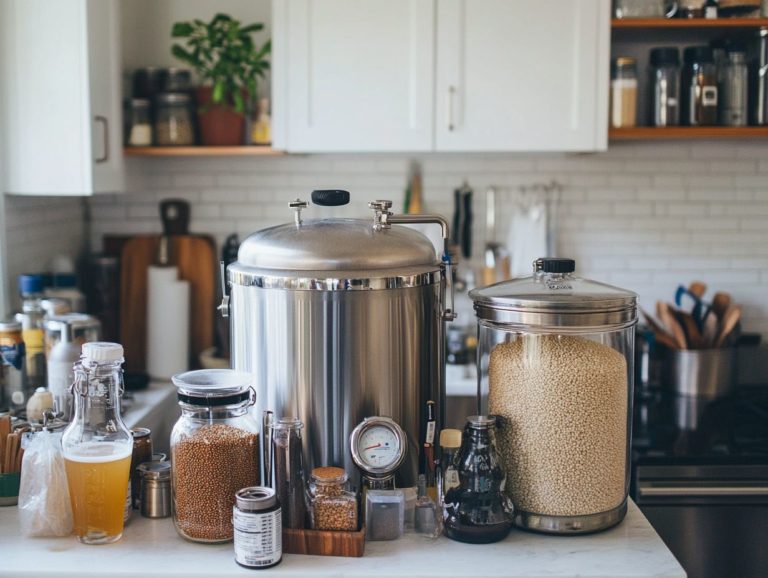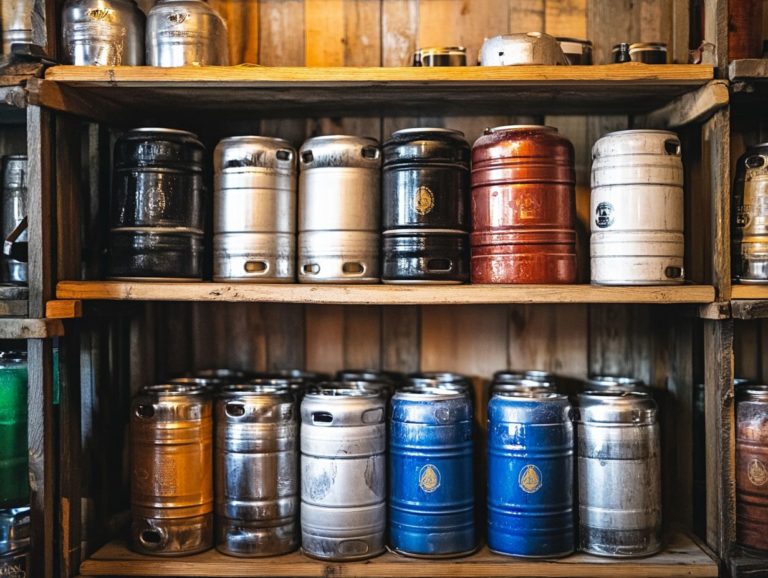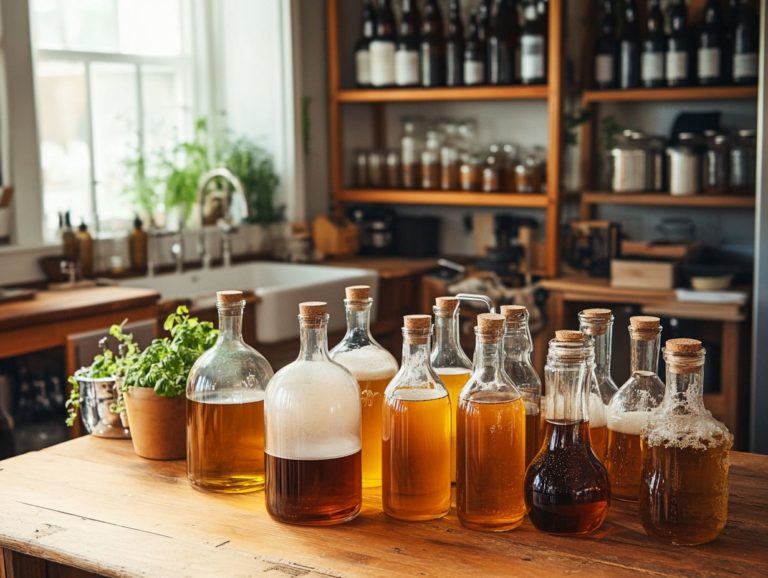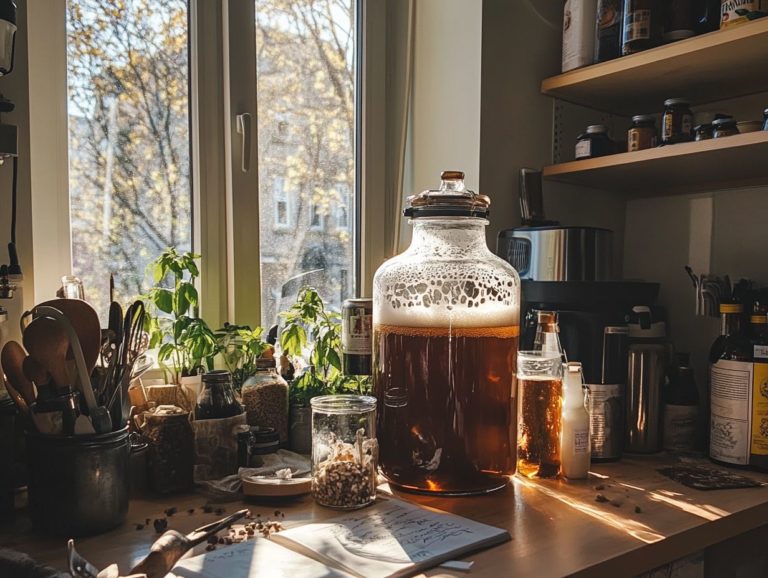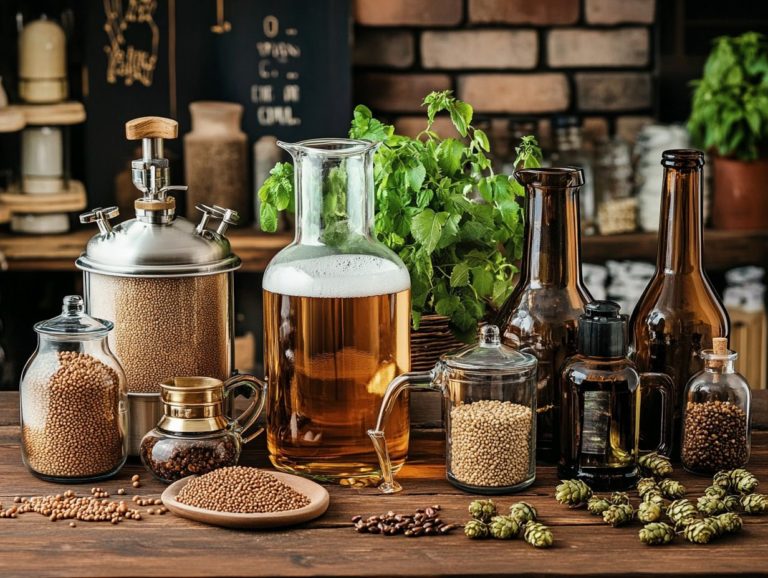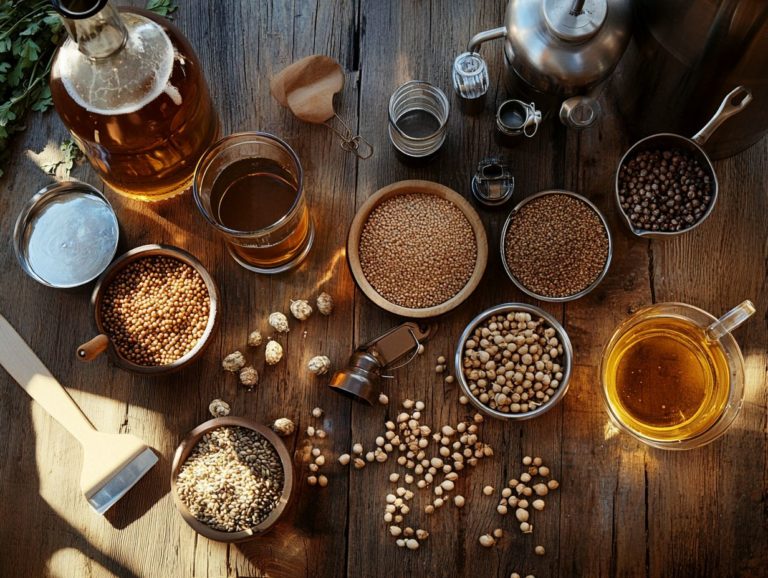How Do I Make a Balanced Beer?
Crafting the perfect beer is truly an art form that relies on achieving a delicate balance among its key components. From grasping the nuances of various beer styles and their unique characteristics to selecting the ideal ingredients and brewing techniques, every step is vital in the beer brewing process.
This article will illuminate essential malts, hops, and yeast strains while offering invaluable tips for mastering your homebrewing skills. Get ready to uncover the secrets to crafting a flavor profile that will thrill your taste buds!
Contents
- Key Takeaways:
- What is a Balanced Beer?
- What are the Different Styles of Beer?
- How Do I Choose the Right Ingredients for a Balanced Beer?
- What is the Brewing Process for a Balanced Beer?
- How Do I Achieve Balance in My Beer?
- What Are the Key Factors to Consider for Balance?
- How Can I Adjust the Flavor Profile of My Beer?
- What are Some Tips for Making a Balanced Beer?
- Frequently Asked Questions
Key Takeaways:
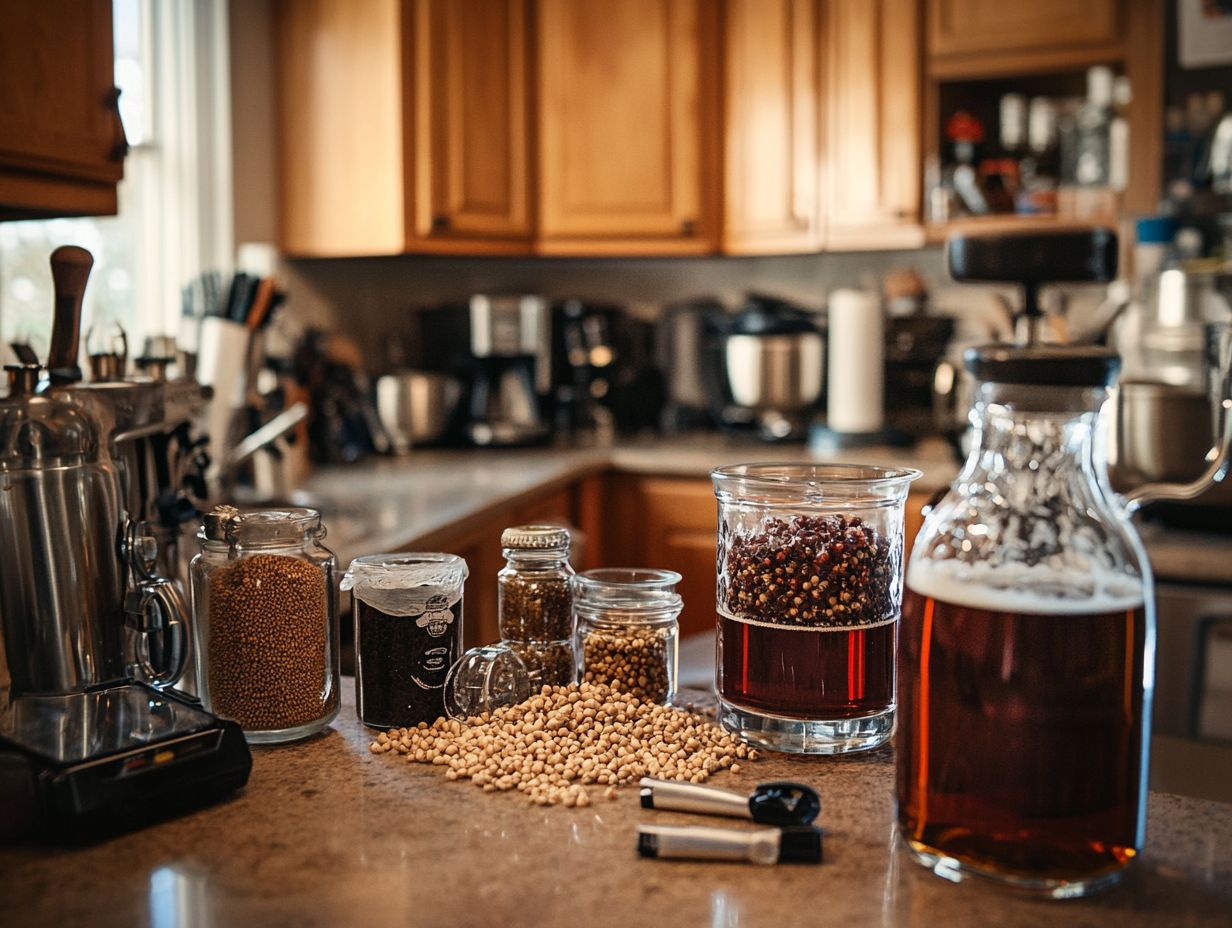
- Understanding the key components of a balanced beer, including malt, hops, yeast, and water, is essential for creating a well-rounded and harmonious flavor profile.
- Knowing the different styles of beer and their characteristics can help in selecting the right ingredients and brewing process to achieve balance, taking into account factors like International Bitterness Units (IBU) and malt percentages.
- To achieve balance in a beer, it is important to consider factors such as alcohol content, flavor profile, and water chemistry, and make adjustments through careful ingredient selection and brewing techniques.
What is a Balanced Beer?
A balanced beer is a carefully crafted masterpiece that achieves a perfect harmony between sweetness and bitterness, ensuring that no single flavor dominates the others.
The essence of balanced brewing lies in your meticulous selection of ingredients. Malts, hops, and yeast all play crucial roles in shaping the overall profile of the beer. For instance, when you pour yourself a well-executed amber ale, you’ll find the delightful marriage of malt sweetness and hop bitterness, creating an inviting and refreshing experience.
By mastering the brewing process, you can employ various techniques to achieve that sought-after equilibrium, leading to a diverse spectrum of beer styles that cater to every palate. Consulting resources like the Brewers Association and engaging in beer judge training can further refine your skills.
What are the Different Styles of Beer?
The world of beer presents a fascinating tapestry of styles that cater to a wide array of tastes and preferences. From the deep, complex notes of an amber ale to the velvety smoothness of a southern English brown ale, each beer style tells its own story. These unique characteristics arise from the careful selection of ingredients and the artistry of brewing techniques.
Craft beer has surged in popularity, with many breweries like Brooklyn Brewery, BrewDog, and Ballast Point boldly experimenting with diverse flavor profiles to produce innovative and captivating creations. By exploring the various beer styles, you not only elevate your own beer experience but also cultivate a deeper appreciation for the intricate brewing process that brings these delightful beverages to life. Start your beer brewing journey now!
What are the Characteristics of Each Style?
Each beer style presents its own distinct characteristics that define its flavor, aroma, and mouthfeel. You ll notice this in everything from the bitterness measured in IBU (International Bitterness Units) to the sweetness derived from various malts.
Take an amber ale, for instance; it typically offers a harmonious sweetness from caramel malts, balanced with moderate bitterness. In contrast, a southern English brown ale showcases delightful nutty and toasty flavors, finishing smoothly.
Don t overlook the role of carbonation, either it significantly affects the overall beer experience, influencing mouthfeel and drinkability. By understanding these nuances, you can improve your beer tasting and deepen your appreciation for each unique style.
Consider the IPA (India Pale Ale), which is celebrated for its bold hop flavor that often brings forth fruity or floral notes. This contributes to a pronounced bitterness that can vary widely. The brewing process often includes dry hopping, which involves adding hops after boiling to enhance aroma without contributing bitterness.
Varieties like Citra and Mosaic from regions like Yakima Valley are particularly popular.
On the flip side, a stout especially an oatmeal stout offers a rich and creamy mouthfeel thanks to the oats in the mash, with layers of chocolate and coffee flavors providing a touch of sweetness.
Each style invites you to explore a world of complexity through aroma, taste, and the tactile sensations imparted by carbonation, transforming beer tasting into an engaging and delightful form of exploration.
What are the Ingredients Used in Each Style?
The ingredients you choose for each beer style are essential for crafting its unique flavor profile and overall characteristics, with malt, hops, yeast strain, and water serving as the primary building blocks.
For instance, when brewing a pale ale, you would typically blend pale malt with aromatic hops, while a stout might call for roasted barley to deliver those rich coffee and chocolate notes.
The yeast strain you select plays a crucial role in fermentation, adding layers of aroma and flavor complexity to your brew. Understanding these ingredients helps you craft exceptional recipes and elevates your overall brewing expertise.
Different styles use these foundational elements to create their signature tastes and aromas. For example, when brewing lagers, you’ll often notice a subtler malt profile complemented by noble hops, leading to a crisp finish.
On the other hand, IPAs are known for their bold hop character, often featuring exotic varieties like Citra or Mosaic to impart intense citrus and tropical fruit flavors.
The use of adjuncts like fruits or spices can further expand the flavor spectrum of these styles. Some brewers even venture into the world of adjuncts, incorporating these elements to refine their brewing techniques and craft recipes that truly embody their personal brewing philosophy.
Commercial breweries often lead the way in these innovations.
How Do I Choose the Right Ingredients for a Balanced Beer?
Selecting the right ingredients for a balanced beer is crucial to achieving the desired flavor and overall harmony in your final product. This process starts with a deep understanding of the base malt, hop varieties, yeast strains, and brewing water that will form the backbone and character of your brew.
For example, finding the perfect equilibrium between malt sweetness and hop bitterness can result in an inviting offering, like a meticulously crafted IPA. By looking into various brewing techniques and thoughtfully incorporating the right ingredients, you can create innovative beer recipes that not only showcase balance but also embody complexity.
What are the Best Malts to Use?
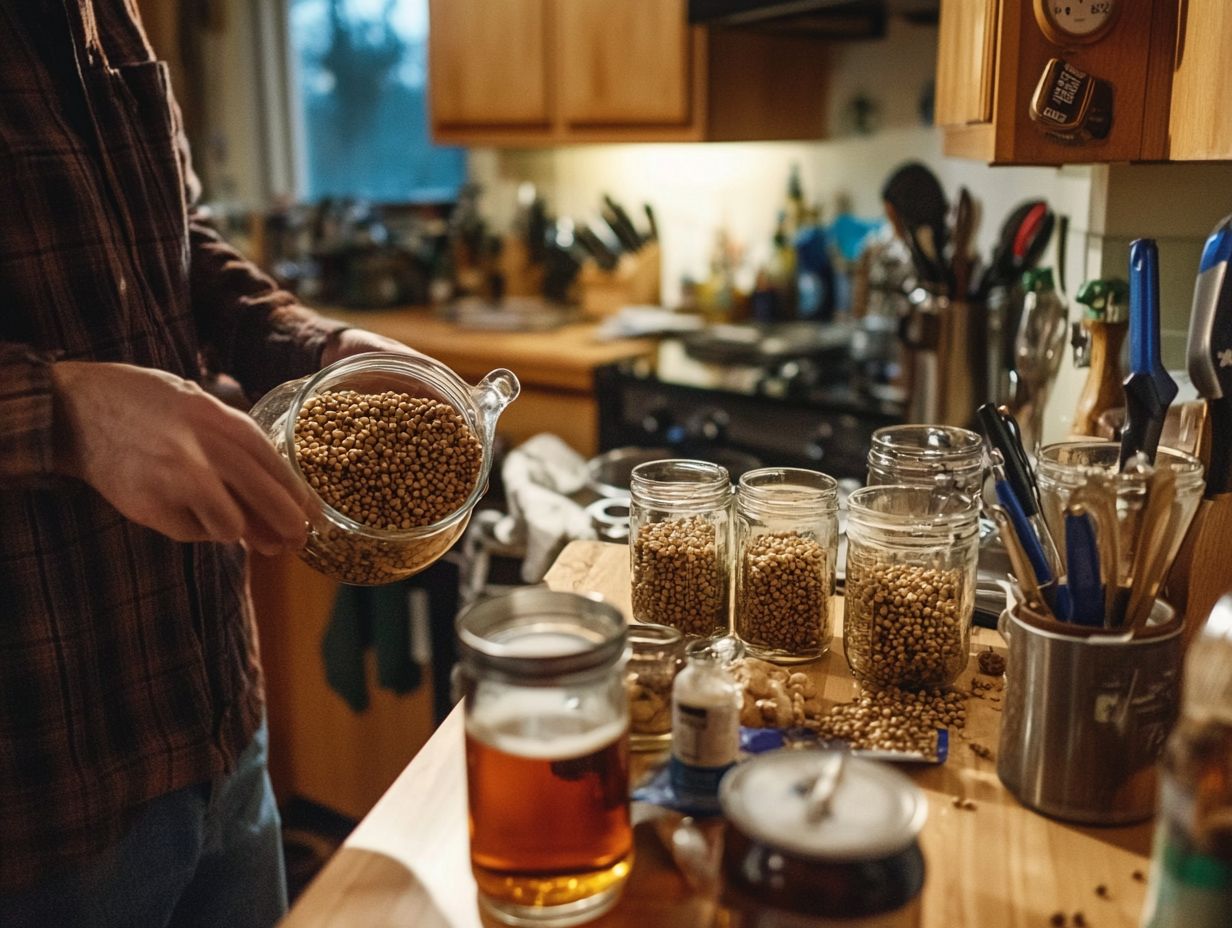
Your choice of malts is absolutely pivotal in brewing balanced beers, as each type imparts a unique blend of flavors, aromas, and levels of sweetness to the final product. For instance, you might opt for caramel malt to add a rich sweetness and beautiful color, while pilsner malt serves as a light, crisp foundation for various styles. The correct malt percentage ensures a balanced flavor and complexity.
By understanding the characteristics of different malts and their contributions to sweetness and body, you can craft recipes that achieve both flavor balance and complexity. Playing with barley in different percentages can also significantly influence the overall mouthfeel and profile of your beer.
Each malt not only enriches the flavor but also affects the beer’s color and clarity. Take roasted malts, for example these bring delightful dark chocolate and coffee notes, essential for styles like stouts and porters, enhancing thickness and richness. Balancing these with proper water chemistry can make a significant difference.
Munich malt, with its slightly toasted character, shines in lagers and bocks, while wheat malt adds a creamy mouthfeel and helps with head retention. By grasping the unique contributions of these malts, you can freely experiment during the mashing and boiling stages of brewing, ultimately creating a final beverage that is both harmonious and distinctly yours.
What are the Best Hops to Use?
When you embark on the journey of creating balanced beers, choosing the right hops is crucial, as it greatly affects the bitterness and aroma of your final brew. Each hop variety brings its own unique traits to the table; some are perfect for bittering, while others shine in delivering aroma and flavor. Understanding alpha acid content and hops utilization is key to balancing these elements.
Take Fuggle hops, for instance they re celebrated for their mild bitterness and earthy aroma, making them a fantastic choice for English-style ales. By grasping the nuances of hop utilization and learning to calculate IBU (International Bitterness Units) and alpha acid, you can master that delicate balance between bitterness and other flavor elements.
Varieties like Cascade and Centennial are also noteworthy, revered for their zesty floral and citrus notes that can truly enliven American IPAs. Timing is everything when incorporating hops into the brewing process; adding them early in the boil ramps up the bitterness, while adding them later enhances the aroma and flavor. Don t shy away from dry hopping either; this technique can elevate those aromatic qualities while keeping bitterness in check. Using brewing tips from experts like John Palmer can also be beneficial.
By thoughtfully selecting and employing various hop varieties, you can craft a well-rounded and captivating drinking experience that delights the palate. Engaging with resources like Craft Beer & Brewing Magazine or joining a beer tasting panel can further enhance your hop knowledge.
What are the Best Yeast Strains to Use?
The yeast strain you select for fermentation plays a crucial role in achieving balanced beers, influencing both the flavor profile and aroma of your final product. The right yeast strain can also enhance fruit flavors, contributing to the beer’s complexity.
Choosing the right yeast strain is not merely a technical choice; it fundamentally shapes the nuances of your beer, providing a rich spectrum of expressions for you to explore. For instance, Belgian yeast strains are celebrated for their ability to produce complex, spicy, and fruity notes, making them perfect for styles like Tripels and Saisons. On the other hand, lager yeast, such as Saccharomyces pastorianus, emphasizes clean and crisp profiles that are essential in classics like Pilsners, amber ales, and Helles.
By understanding these characteristics, you can intentionally craft beers that resonate with specific taste preferences, ensuring a delightful beer experience for every palate. Moreover, considering the various hops varieties and malts percentage can further refine the flavor nuances in your brews.
What is the Brewing Process for a Balanced Beer?
The brewing process for a balanced beer is a detailed process where each step is essential to achieving a harmonious blend of flavors and aromas in the final product. Start by selecting high-quality ingredients, as this foundation is pivotal to your outcome.
The adventure begins with mashing the grains to extract fermentable sugars, followed by a boiling phase where hops are introduced for the perfect balance of bitterness and aroma. Next comes fermentation, where your chosen yeast strain converts sugars into alcohol, crafting a brew that is both balanced and flavorful. The quality of your brewing water also significantly affects the final product.
Following brewing guidelines at every stage is vital for ensuring exceptional results.
What are the Steps Involved in Brewing?
The art of brewing a balanced beer encompasses several critical steps: mashing, boiling, fermentation, conditioning, and packaging. Each stage plays a vital role in crafting the final product.
Understanding these processes is essential for achieving a harmonious flavor profile. Mashing, typically conducted at temperatures between 150-160 F, extracts sugars and shapes the beer’s body and mouthfeel. The boiling phase, lasting between 60 to 90 minutes, is critical for sterilization and extracting hops, significantly influencing bitterness and aroma.
During fermentation, various yeast strains thrive, each imparting distinct characteristics. Selecting the right strain is crucial for flavor development. Conditioning allows flavors to meld and mature, marking a pivotal period for achieving the desired clarity and smoothness before packaging.
Master these brewing fundamentals to create unique and balanced beers that truly stand out in a crowded market.
How Do I Control the Alcohol Content and Bitterness of My Beer?
Controlling the alcohol content and bitterness of your beer is crucial for creating a balanced flavor profile that caters to diverse tastes. The alcohol level is largely determined by the fermentable sugars found in the wort and the yeast strain selected for fermentation. Bitterness is measured using International Bitterness Units (IBU), which you can manipulate by choosing the type and amount of hops introduced during the boiling phase. The alpha acid content in your hops is critical for achieving the desired bitterness. By monitoring these factors throughout the brewing process, you can craft a beer that resonates with consumer preferences.
Manage these elements by adjusting your mash temperatures. Lower temperatures typically yield a higher sugar concentration, leading to increased alcohol production. For bitterness, explore late hop additions or dry hopping; these techniques enhance aroma without significantly raising the IBU.
Selecting yeast strains with specific attenuation rates allows you to control the final alcohol content while maintaining desired flavors. Keeping detailed notes on each brewing session will hone your skills and contribute to achieving that perfect balance, as understanding and fine-tuning these variables is key to mastering brewing.
How Do I Achieve Balance in My Beer?
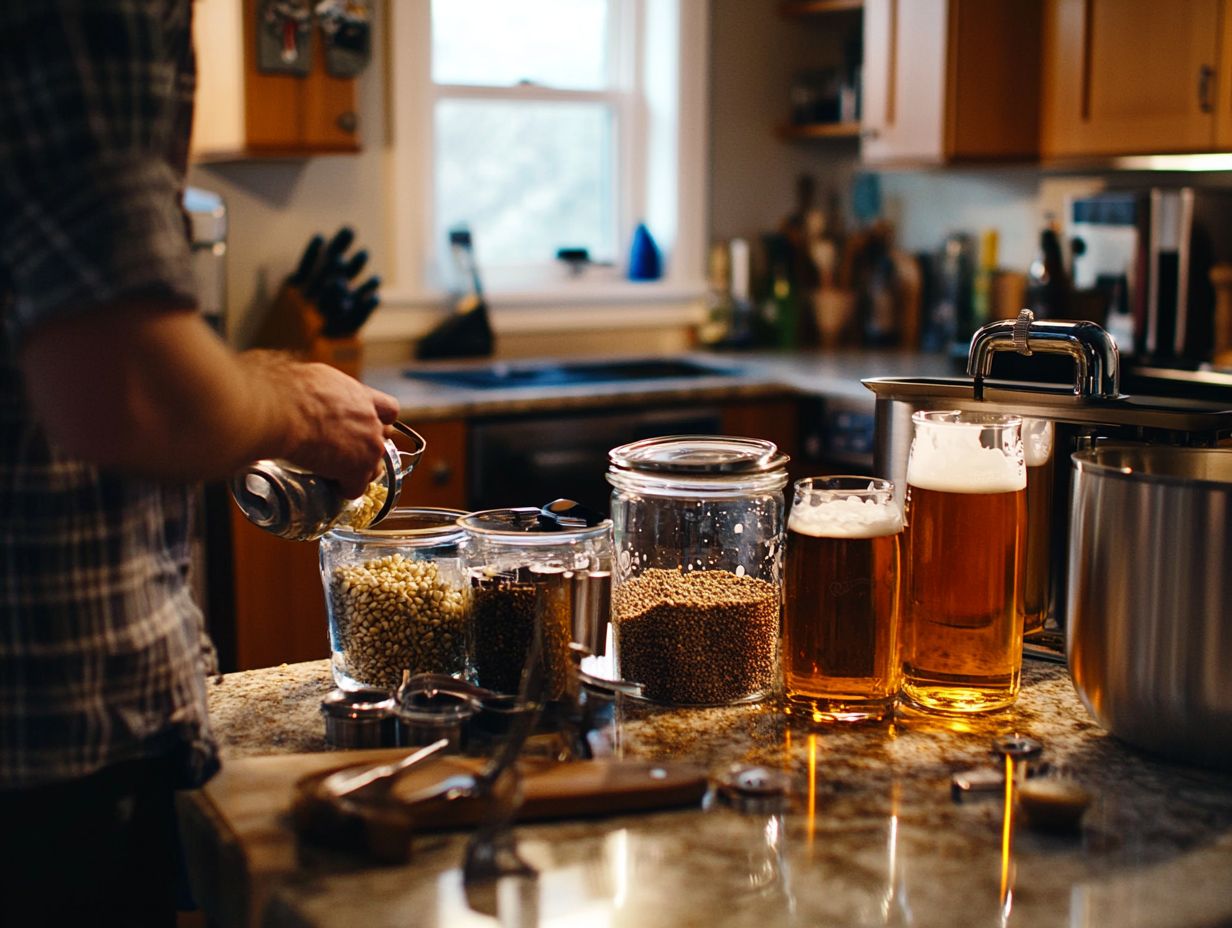
Achieving balance in your beer requires a thoughtful exploration of how various flavor components, ingredients, and brewing techniques interact throughout the process. The secret to crafting a well-balanced beer lies in harmonizing the sweetness from malt with the bitterness from hops, while also integrating the aromatic qualities from yeast and other flavoring agents.
Experiment with different ingredients and their proportions to fine-tune your recipes for that ideal equilibrium. Adhering to established brewing guidelines provides a solid framework for developing balanced beers that appeal to discerning preferences.
In conclusion, start your brewing journey today! Experiment with different techniques and ingredients to create your own balanced beers that will impress your friends and family.
What Are the Key Factors to Consider for Balance?
Several key factors contribute to achieving balance in your beer, including the selection of ingredients, brewing techniques, and the overall flavor profile of the final product. The choice of malts and hops will directly impact the sweetness and bitterness levels, while different yeast strains can influence both aroma and complexity.
Pay attention to brewing techniques such as mashing temperature and fermentation control. These play a vital role in shaping the character of your beer. By understanding and skillfully manipulating these factors, you can create a harmonious experience that resonates deeply with beer enthusiasts.
Consider, for example, the use of caramel malts. They can enhance sweetness and color in your brew, resulting in a richer mouthfeel. Meanwhile, bittering hops like Magnum can counterbalance that sweetness, creating a delightful contrast.
When you select specific yeast, you have the opportunity to elicit fruity esters or spicy phenols, adding intriguing layers to the aroma. Variations in the fermentation process the conversion of sugar to alcohol like temperature fluctuations, can lead to distinct flavor expressions, ensuring that each batch you produce is unique.
Additionally, utilizing brewing software for precise calculations can aid in recipe development and maintaining consistency. The magic happens when these elements interact, defining your beer s unique essence and transforming simple recipes into extraordinary craft experiences!
How Can I Adjust the Flavor Profile of My Beer?
Adjusting the flavor profile of your beer is essential for achieving balance and ensuring that the final product aligns with your desired taste preferences. You have a variety of methods at your disposal, such as tweaking the ratios of malt and hops to manipulate sweetness and bitterness levels. The timing of your hop additions during the brewing process can significantly enhance or diminish specific flavor characteristics.
Experimenting with different yeast strains and fermentation techniques is crucial for modifying the overall profile. By grasping how each component interacts, you can create custom beers that cater to a diverse range of palates.
For instance, you might choose a higher ratio of caramel malts to introduce richness and toasty notes, or you could opt for lighter base malts for a cleaner finish. Adding specialty grains can infuse unique flavors like chocolate or coffee, enhancing the beer’s depth.
Regarding hops, employing late hopping techniques allows you to showcase floral and citrus aromas without overwhelming the beer with bitterness. Experimenting with fermentation temperatures can yield varying esters and phenols, creating a more complex bouquet.
Use these methods now to refine your creations and take your brewing to the next level! You ll ultimately craft a truly satisfying drinking experience.
What are Some Tips for Making a Balanced Beer?
Crafting a balanced beer demands a blend of skill, knowledge, and a dash of experimentation. Follow these key tips to guide your brewing journey toward success:
- Start with quality ingredients that complement each other ensuring that your selected malts, hops, and yeast work in perfect harmony is paramount.
- Familiarize yourself with the brewing techniques and guidelines specific to your chosen beer style, as this provides a solid foundation for your efforts.
- Regularly taste your brew throughout the process; this will be invaluable, allowing you to make necessary adjustments for a well-rounded flavor profile.
- Keep detailed notes to assist you in refining your recipes and honing your craft for future brews.
How Do I Maintain a Clean and Sanitary Brewing Environment?
Maintaining a clean and sanitary brewing environment is essential for the success of your balanced beer. Contamination can wreak havoc on fermentation and flavor. Therefore, before you start brewing, make it a point to thoroughly clean and sanitize all your equipment think fermenters, bottles, and utensils using the right cleaning agents and methods.
During the brewing process, be vigilant about minimizing exposure to airborne contaminants and handling ingredients with care. Utilizing distilled water can also reduce the risk of contamination. By prioritizing cleanliness, you enhance the integrity of your brews and prevent unwanted flavors from sabotaging the intended balance.
Sanitation is not just a chore; it plays a pivotal role in preserving the intended taste and fostering a healthy fermentation environment. For example, using a no-rinse sanitizer after washing your equipment is a smart move to eliminate any microorganisms that could spoil your beer. Regularly monitoring your brewing area for cleanliness can significantly reduce the risks of cross-contamination.
By utilizing proper brewing techniques and brewing tips, you can ensure a safe environment for brewing. Once fermentation is complete, don t overlook the importance of properly cleaning your kegs and lines. This step is vital to ensuring that each batch maintains its unique characteristics.
By implementing these best practices and leveraging brewing software, you cultivate a superior brewing process, where the only elements influencing the final product are the carefully chosen ingredients and brewing water.
Common Mistakes in Craft Beer Brewing
Avoiding common mistakes is crucial for crafting balanced beers. Missteps in technique or ingredient selection can lead to undesirable flavors and imbalances. One prevalent error is neglecting to measure ingredients properly. This can distort the intended flavor profile, resulting in excessive bitterness or sweetness. Utilizing recipe software helps manage these measurements accurately.
Failing to control temperature during fermentation can also produce off-flavors and compromise the beer’s overall character. By being mindful of these pitfalls and adhering to established brewing techniques, you achieve the harmonious balance you seek in your creations.
Another frequent oversight is inadequate sanitation, which can introduce unwanted bacteria and spoil your final product. Always clean and sanitize your equipment before use to avoid ruining your hard work. Proper use of distilled water can also help maintain sanitation standards.
Many brewers underestimate the importance of oxygen exposure, leading to oxidation that negatively affects flavor. To prevent this, it s vital to minimize contact with oxygen during the transfer and packaging stages. Understanding brewing chemistry (the study of chemical processes in brewing) can also aid in controlling oxygen exposure.
By understanding and fixing these common mistakes, you can enhance the quality of your beer and contribute to a more enjoyable tasting experience for both enthusiasts and casual drinkers alike. Consulting sources like Craft Beer & Brewing Magazine can provide additional insights.
Frequently Asked Questions
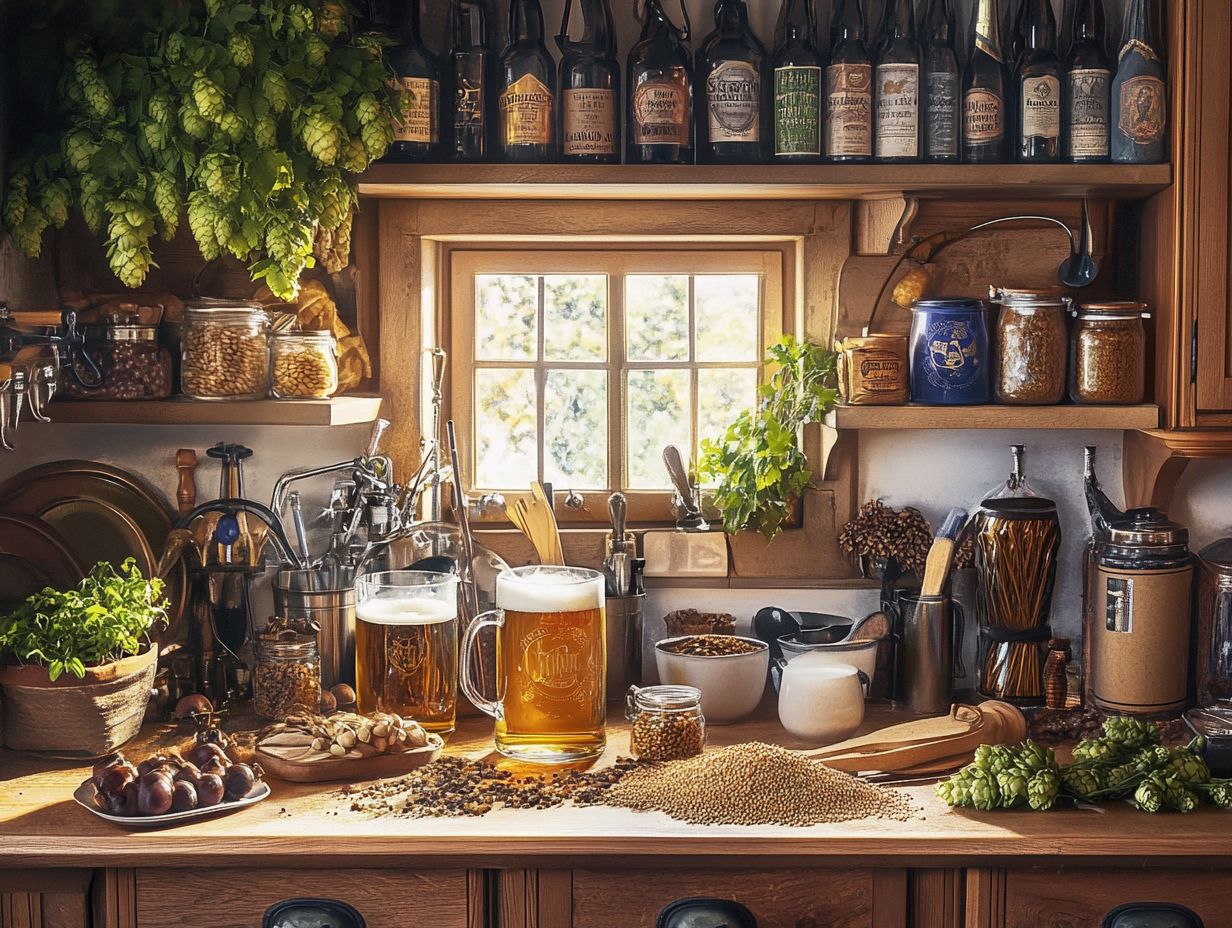
What is a Balanced Beer?
A balanced beer is one that has a harmonious blend of flavors and aromas, with no one aspect overpowering the others. It should have a pleasant level of bitterness, sweetness, and alcohol content, with each component working together to create a well-rounded taste. The optimal IBU (International Bitterness Units, which measure the bitterness of beer) and alpha acid content from hops are crucial in achieving this balance.
How Do I Achieve Balance in My Beer?
To make a balanced beer, you need to carefully choose and proportion your ingredients. This includes selecting the right malt, hops, and yeast, as well as controlling the fermentation process. It’s also important to taste and adjust your beer throughout the brewing process to ensure all flavors are well-balanced.
Understanding hops utilization (the process of extracting flavors and aromas from hops) and the role of malt sweetness can greatly aid in this process.
Can I Use Any Type of Malt in a Balanced Beer?
Yes, you can use any type of malt in a balanced beer as long as it is used in the right proportions.
Malt provides the sweetness and body in beer. It’s important to choose one that complements the other flavors in your recipe.
Popular malts like caramel malt or barley can add different dimensions to your beer.
What Role Do Hops Play in Creating a Balanced Beer?
Hops add bitterness to beer and contribute to its aroma and flavor. When used correctly, hops can provide a pleasant balance between bitterness and sweetness in a beer.
Choosing the right hops is key to crafting a memorable beer experience! Using different hops varieties, such as Fuggle hops, can influence the final flavor.
Why Is It Important to Control the Fermentation Process for a Balanced Beer?
Fermentation is a crucial step in creating a balanced beer as it affects the flavor and alcohol content.
By controlling the temperature, yeast type, and fermentation time, you can ensure that the beer’s flavors are well-balanced and not overpowered by any single component.
Choosing the right yeast strain and managing the carbonation the bubbles in your beer that create its fizz can significantly impact the final quality.
How Can I Tell If My Beer Is Well-Balanced?
The best way to determine if your beer is balanced is to taste it.
A well-balanced beer should have a pleasant and harmonious blend of flavors, with no one aspect standing out or overpowering the others.
It should also have a clean finish and leave you wanting another sip.
You can engage a beer tasting panel or get feedback from a beer judge for valuable insights.
So why wait? Start experimenting with different malts and hops today to create your perfect balanced beer!

